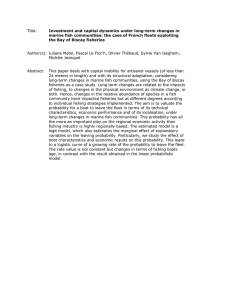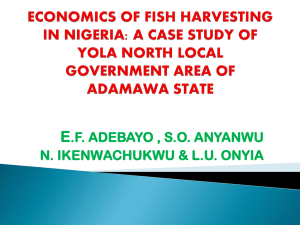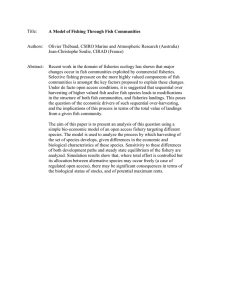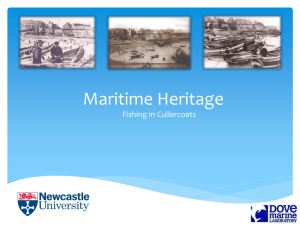Document 14092572
advertisement
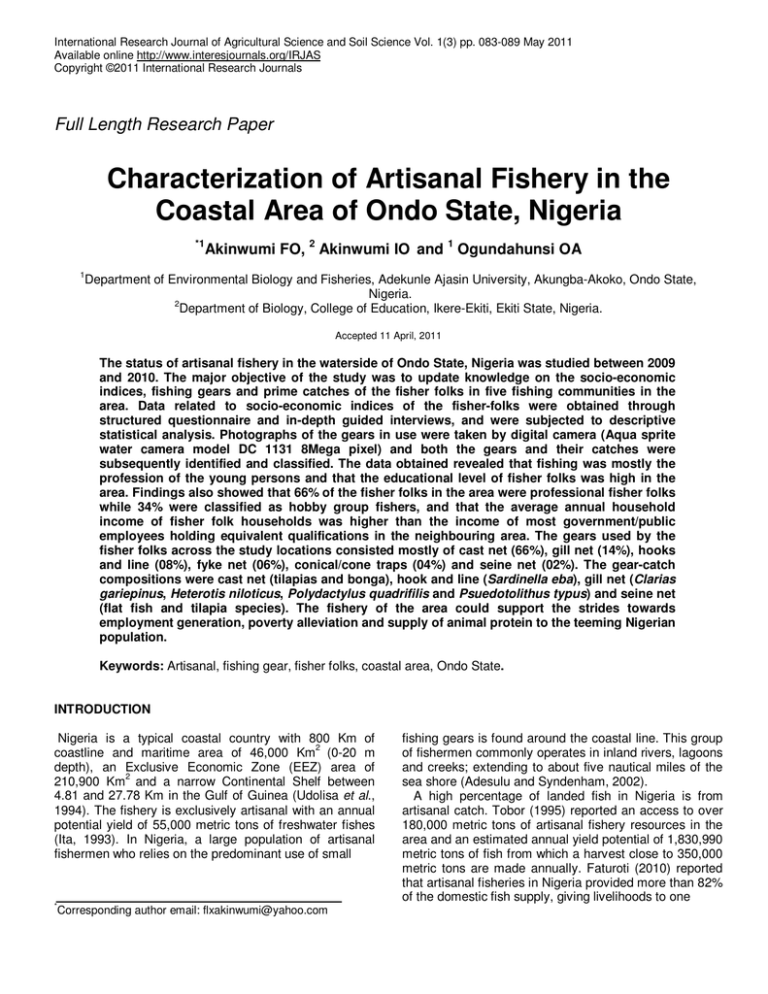
International Research Journal of Agricultural Science and Soil Science Vol. 1(3) pp. 083-089 May 2011 Available online http://www.interesjournals.org/IRJAS Copyright ©2011 International Research Journals Full Length Research Paper Characterization of Artisanal Fishery in the Coastal Area of Ondo State, Nigeria *1 Akinwumi FO, 2 Akinwumi IO and 1 Ogundahunsi OA 1 Department of Environmental Biology and Fisheries, Adekunle Ajasin University, Akungba-Akoko, Ondo State, Nigeria. 2 Department of Biology, College of Education, Ikere-Ekiti, Ekiti State, Nigeria. Accepted 11 April, 2011 The status of artisanal fishery in the waterside of Ondo State, Nigeria was studied between 2009 and 2010. The major objective of the study was to update knowledge on the socio-economic indices, fishing gears and prime catches of the fisher folks in five fishing communities in the area. Data related to socio-economic indices of the fisher-folks were obtained through structured questionnaire and in-depth guided interviews, and were subjected to descriptive statistical analysis. Photographs of the gears in use were taken by digital camera (Aqua sprite water camera model DC 1131 8Mega pixel) and both the gears and their catches were subsequently identified and classified. The data obtained revealed that fishing was mostly the profession of the young persons and that the educational level of fisher folks was high in the area. Findings also showed that 66% of the fisher folks in the area were professional fisher folks while 34% were classified as hobby group fishers, and that the average annual household income of fisher folk households was higher than the income of most government/public employees holding equivalent qualifications in the neighbouring area. The gears used by the fisher folks across the study locations consisted mostly of cast net (66%), gill net (14%), hooks and line (08%), fyke net (06%), conical/cone traps (04%) and seine net (02%). The gear-catch compositions were cast net (tilapias and bonga), hook and line (Sardinella eba), gill net (Clarias gariepinus, Heterotis niloticus, Polydactylus quadrifilis and Psuedotolithus typus) and seine net (flat fish and tilapia species). The fishery of the area could support the strides towards employment generation, poverty alleviation and supply of animal protein to the teeming Nigerian population. Keywords: Artisanal, fishing gear, fisher folks, coastal area, Ondo State. INTRODUCTION Nigeria is a typical coastal country with 800 Km of 2 coastline and maritime area of 46,000 Km (0-20 m depth), an Exclusive Economic Zone (EEZ) area of 210,900 Km2 and a narrow Continental Shelf between 4.81 and 27.78 Km in the Gulf of Guinea (Udolisa et al., 1994). The fishery is exclusively artisanal with an annual potential yield of 55,000 metric tons of freshwater fishes (Ita, 1993). In Nigeria, a large population of artisanal fishermen who relies on the predominant use of small * Corresponding author email: flxakinwumi@yahoo.com fishing gears is found around the coastal line. This group of fishermen commonly operates in inland rivers, lagoons and creeks; extending to about five nautical miles of the sea shore (Adesulu and Syndenham, 2002). A high percentage of landed fish in Nigeria is from artisanal catch. Tobor (1995) reported an access to over 180,000 metric tons of artisanal fishery resources in the area and an estimated annual yield potential of 1,830,990 metric tons of fish from which a harvest close to 350,000 metric tons are made annually. Faturoti (2010) reported that artisanal fisheries in Nigeria provided more than 82% of the domestic fish supply, giving livelihoods to one 084 Int. Res J. Agric. Sci. Soil Sci. million fishermen and up to 5.8 million fisher folks in the secondary sector. The fish community inhabiting the estuaries, creeks and other coastal brackish water consists of both freshwater and marine fish species. The estuarine community includes croakers (Pseudotolithus elongates, P. senegalensis and P. typus), Ethmalosa fimbriata (bonga), Ilisha africana (shad), Chrisichthys nigrodigitatus (brackish water catfish); marine species include Pteroscion peli (drum), Lutjanus dentatus (snapper), Cynoglossus (soles), Pomadasys jubelini (grunters), Arius spp. (marine catfish), Trichiurus lepturus (hairtail/silver fish), Cybium tritor (spanish mackerel), Sardinella spp., Sphyraena spp. (barracuda), tilapiine species, Penaeus notialis (Southern pink shrimp), Parapenaeopsis atlantica (Guinea shrimp), Palaemon sp. (white shrimp) and Macrobrachium sp. (Adesulu and Sydenham, 2002; Ssentongo et al., 1986). The economic importance of these to the community include source of food, provision of employment, source of foreign exchange/income, tool to rural development and source of raw materials to manufacturers (Moses, 2006; Abulude et al., 2006). However, Tietze et al. (2005) noted that the use of poor quality fishing materials can limit fish catch levels and that efforts should generally focus on the quest for improved fishing techniques and gears to replace the low yielding traditional fishing methods. Studies have shown that the commonest gears used in the lower creek of the Niger Delta area included traps, hook and line/long-line and drift/gill nets (Kingdom and Kwen, 2009). Although, artisanal fishery in the area has contributed immensely to the socio-economic conditions of the entire populace due to economic influx of people in search of fish and fish products from the adjoining communities, empirical studies on the status of the artisanal fisher folks in the study area are just growing; this work is therefore aimed at enriching such existing scanty database. The major objective of this study is to update knowledge on the status of artisanal fishery in the waterside of Ondo State with a particular emphasis on the socio-economic indices, fishing gears and prime catches of the fisher folks in the fishing communities. Description of Study Area Ondo State is in south-west of Nigeria with a coastline of about 80 Km which runs in a northwest to southeast direction. The coastal area of Ondo State is largely found in Ilaje Local Government Area with about 50 settlements scattered around the river tributaries that empty directly into the coast and an increasing population size of 2.2% annually (Adebowale et al., 2008). The study area falls within the oil prospecting states in Nigeria called the Niger Delta region which is often referred to as the richest part of Nigeria, in terms of natural resources endowment. Babatunde (2010) reported that 80% of the population of the study area engages in fishing and that the area always records the bulk of fish produced in Ondo State. MATERIALS AND METHODS The coastal area of Ondo State lies on Latitude 50 50'N 60 09'N and Longitude 40 45'E - 50 05’E (Figure 1). Five (5) major fishing communities, Ayetoro, Ugbonla, Awoye, Igbokoda and Oboto were selected in Ilaje Local Government Area of Ondo State. The site selection was based on the population/aggregation of fishing families, geographic distribution, catch volume and species diversities of the fish catches in the area. Identification of gear types used by the fishermen in the area was done through personal contacts and discussions with the fishing families both in their villages and at fishing sites. Photographs of the gears identified were taken by digital camera (Aqua sprite water camera model DC 1131 8Mega pixel). Subsequent identification and classification into various types (active, passive, mechanized and non- mechanized type) were done according to the classification models of Flewwelling et al. (2002). The fishing families were classified into either Professional Full Time (PFF) or Hobby Group Fishers (HGF). The classification was based on the type of boat used, type and size of gear and number of fisher-folks in a group. Data related to socio-economic indices of the fisher-folks in this area were obtained by the use of questionnaires. 20 fishers were randomly selected from each of the five communities, to give a total sample size of 100. Information related to sex, age, marital status, household size, educational background, years of experience, method of fishing, gears type in use, preferred fishing period, size of fishing fleet and the daily income range was obtained through guided interview. Identification of exploitable fin and shell fishes found in the artisanal catches in the area was according to Adesulu and Sydenham (2002). This helped to link each species of fresh and brackish water fishes in the study area to their fishing methods and the gear type used by the artisanal fishermen in the area. The data obtained were analyzed using descriptive/inferential statistics and charts of explanatory variable. RESULTS AND DISCUSSION Results on the demographic parameters of the fisher folks in the study area are presented in Table 1. The results in the table show that fishing was practiced by youths of both sexes but with a preponderance of males in most of the sites. Although, the results showed the dominance of the artisanal fisheries sector by men, the Akinwumi et al. 085 Figure 1. Study area: Ilaje Local Government Area, Ondo State, Nigeria Table 1. Demographic parameters of fisher folks in the study area Parameter Range % Demographic Parameter in Study Locations Ayetoro Ugbonla Awoye Igbokoda Oboto Age < 20yrs 21-40yrs 41-60yrs 0 100 0 10 90 0 10 90 0 10 90 0 0 100 0 Sex Male Female 50 50 60 40 70 30 70 30 70 30 Marital Status Single Marital 50 50 40 60 45 55 40 60 30 70 House Hold Size Nuclear Extended 100 0 100 0 90 10 100 0 100 0 Experience 6-10yrs 11-15yrs >15yrs 40 40 20 30 70 0 30 60 10 50 30 20 40 40 20 Educational Qualification None Primary Senior Secondary Tertiary 0 60 40 0 50 50 0 50 50 0 45 55 0 40 60 0 0 0 0 0 086 Int. Res. J. Agric. Sci. Soil Sci. contribution of the women folk in fishing activities cannot be underrated. According to Williams (2002), women mostly use traps and nets to catch fish in most fishing communities in Nigeria, and are also actively involved in fish processing and marketing. The predominant processing and preservation techniques employed in the area are smoke-drying (93.75%) with sun-drying accounting for 6.25% (Adeparusi et al., 2003). However, a number of socio-cultural factors, such as, restricted access to water resources, low technical know-how and lack of credit facilities limit women full participation in the small-scale fisheries sector. Contrary to the widely held assumption that the standard of education could be low in most fishing settlements, the data obtained in this study showed that the educational attainment of fisher folks was high in the area. At least, 40% of the fisher folks in each of the fishing communities acquired the senior secondary education. Adeparusi et al. (2003) in their study of artisanal fishers in Ilaje, Ondo State, Nigeria also reported that 67.5% were literate having primary, secondary or higher education while 32.5% were illiterate. The relative high level of education of fisher folks could give such households the capacity to successfully implement income diversification strategies to cope with income fluctuations, income failure and poverty. Bravo-Ureta and Evenson (1994) noted that where there were no local alternatives to fishing, fisher folks were either forced to over-exploit fishery resources above the level that would occur if alternative livelihoods and income sources were available to them or to migrate to urban areas. There is no agreement on whether or not crops and livestock farmers have a higher educational status than fisher folks. Tietze et al. (2005) reported that farmers had higher levels of education than fisher folks in Malaysia and Bangladesh whereas fisher folks had a higher level of education than agriculturists in India and Senegal. The year of practice of the fisher folks in the study area is an indication that fishing was popular and widely practiced by the respondents on the completion of the junior secondary education. The study also revealed that 59% of the fisher folks aged between 21 and 40 years were married and operated the nuclear family. AER (2003) reported that the age of marriage for fishermen in the Philippines and Bangladesh was usually 25–27 and 22–23 in India and Senegal. The authors further noted that the age for females was lower than for males in all instances, but the difference is much smaller in the Philippines and India (usually three to five years) than in Bangladesh and Senegal (usually six to 10 years). Classification of fishermen into the operational fishing groups was done according to the level of sophistication of gears used, fishing areas, catch volume per day and number of fishermen per fishing group across the study locations. The characteristic features of both PFF and HGF are illustrated in Figures 2 and 3. The data obtained show that 66% of the fisher folks in the area were PFF while 34% were classified as HGF. The daily income analysis of the fisher folks across the study locations was observed to be solely dependent on catch volume, type of fish or species compositions of Akinwumi et al. 087 catch the freshness of the fish. Figure 4 shows the percentage distribution of the income status of the fisher folks on daily basis. Observations showed that PFF operating with active gears made an average catch of 11- 088 Int. Res. J. Agric. Sci. Soil Sci. Table 2. Identification and distribution of gear type in the study locations English name Local name (Yoruba) Gear classification % Distribution across fishing villages Active Passive Ayetoro Ugbonla Awoye Igbokoda Oboto √ 10 10 10 10 30 70 70 60 60 70 Gill Net Awo Cast Net Obiriki Fyke Net Asun √ 0 0 30 0 0 Hook and Line Aghor √ 10 0 0 30 0 Conical Cone Trap Agbone √ 0 20 0 0 0 Seine Net Irere 10 0 0 0 0 √ √ √ indicates whether gear is active or passive 20 Kg of fish per day while the HGF caught less than 10 Kg of fish per day. In spite of declining catches, the average annual household income of fisher folk households was higher than the income of most government/public employees holding equivalent qualifications in Nigeria. This observation is in agreement with Anyanwu et al. (2009) who reported that an average fisherman along River Niger in Onitsha, Nigeria made a gross profit margin of about N96000 per month in a year. In addition, Tietze et al. (2000) and AER (2003) in their studies of selected coastal Asian and African countries noted that the savings rate and the amounts saved were generally higher in fishing villages than in neighbouring farming villages. The authors further reported that in most of the countries studied, households in farming villages were as indebted as or more indebted than households in fishing villages. These reports are contrary to the popular belief that fisher folks are among the poorest of the rural population in coastal areas of the world. Fishing operations across the study locations were carried out in rivers, lagoons and the sea. Thus, the fish community inhabiting the estuaries, creeks and other coastal brackish water consisted of both freshwater and marine fish species. The nature of the fishing grounds and the dominant population of fish species around each study location were observed to directly determine the type of gears used by the respective fishermen. The identification and distribution of gear types across the study locations are shown on Table 2. The gears used by the fisher folks across the study locations consisted mostly of cast net (66%), gill net (14%), hooks and line (08%), fyke net (06%), conical/cone traps (04%) and seine net (2%). Cast net was the most frequently used in the area and effective in catching tilapias and bonga, hooks and line were used to catch S. eba (sardine), gill net was mostly used for other pelagic species of fish, such as, Clarias gariepinus (catfish), Heterotis niloticus (Heterotis), Polydactylus quadrifilis (trunkfish) and Psuedotolithus typus (typus) while seine net was used to catch crayfish and some pelagic fish such as flat fish and tilapia species. Kingdom and Kwen (2009) reported that the gears in use in the lower creek of the Niger Delta included traps (60%), hook and line/longline (60%) and drift/gill nets (47.8%), and that more than 70% of fishers had more than three fishing gears in-use. The findings in this study are in agreement with Adeyemi et al. (2009) who reported that gill nets, cast net, Malian trap and long lines were typical of most Nigeria’s waters and that their catches generally included small sized fish, notably Tilapia (comprising Oreochromis niloticus and Tilapia zillii), H. niloticus, Clarias sp, fingerlings of Clarias and Tilapia sp respectively. The number of years of fishing among the fishermen in the study area ranged between 6–15 years. However, while an average of 38% of the fishers had up to 10 years of fishing experience, only 40% had up 15 years of experience while only 14% had been in the business for more than 15 years. The distribution indicates that the respondents were relatively young in the business and this probably explains the preponderance use of passive gears, and hence the pelagic catches observed in the study area. Inoni and Oyaide (2007) noted that fishers, particularly those in the motorized sector of the artisanal fishery, require adequate experience to be able to exploit more valuable fish species in deeper waters. Akinwumi et al. 089 CONCLUSION The artisanal fishery of the coastal area of Ondo State holds great potentiality in terms of natural yield which could support the government strides towards employment generation, poverty alleviation and supply of animal protein to the teeming Nigerian population. It is recommended that government should intensify the right support in terms of aids and infrastructures and give localized informal training to fisher folks on the ways of improving fishing methods for sustainable management of the fishery of the area. REFERENCES Abulude FO, Lawal LO, Ehikhamen G, Adesanya WO, Ashafa SL (2006). Chemical composition and functional properties of some prawns from the coastal area of Ondo State, Nigeria. Electron. J. Environ. Agric. Food Chem. 5 (1), 1235-1240. Adebowale KO, Agunbiade FO, Olu-Owolabi BI (2008). Impacts of natural and anthropogenic multiple source of pollution on the environmental conditions of Ondo State coastal water. Nig. J. Env. Agric. Food Chem. 2798-2810. Adeparusi EO, Ajibefun AI, Akeremale EO (2003). Smoke-curing of fish by artisanal fisherfolks in Ilaje, Ondo State, Nigeria. Asset Ser. A 3 (4):101-109. Adesulu EA, Sydenham DHJ (2002). The freshwater fishes and fisheries of Nigeria. Macmillan Nigeria Publishers, Lagos, pp: 397. Adeyemi SO, Bankole NO, Adikwu IA (2009). Fish Gear Survey of Gbedikere Lake, Bassa, Kogi State, Nigeria. Int. J. Lakes Rivers, 2(1): 53-56. Annual Economic Report (AER) (2003). Concerted action: Co-ordination of research in fishery economics and promotion of common methods for economic assessment in EU fisheries. Euro. Fish. Fleets Ann. Rep. pp: 289. Anyanwu DC, Mkpado M, Ohaka CC (2009). Economic analysis of artisanal fishing at River Niger Onitsha, Anambra State, Nigeria. Agro-Sc. 8(3): 175-179. Babatunde A (2010). The Impact of oil exploitation on the socioeconomic life of the Ilaje-Ugbo people of Ondo State, Nigeria. J. Sust. Dev. Afr. 12(5): 61-84. Bravo-Ureta, BE, Evenson RE (1994). Efficiency in agricultural production: The case of peasant farmers in eastern Paraguay. American J. Agric. Econ. 27-37. Faturoti O (2010). Nigeria: Fisheries contribute $US1 billion to th economy. 25 Annual Conf. Fish. Soc. Nigeria, Badagry, Lagos, Nigeria. Flewwelling PC, Cullinan D, Balton R, Sautter P, Reynolds JE (2002). Recent trends in monitoring, control and surveillance systems for capture fisheries. FAO Fish. Tech. Pap. No. 415. FAO, Rome, pp: 200. Inoni OE, Oyaide WJ (2007). Socio-economic analysis of artisanal fishing in the south agro-ecological zone of Delta State, Nigeria. Agric. Trop. Subtrop. 40 (4)135-149. Ita EO (1993). Inland fishery resources of Nigeria. CIFA. Occa. Pap. No. 21. FAO, Rome, pp: 52. Kingdom T, Kwen K (2009). A survey of fishing gear and methods in the Lower Taylor Creek Area of Bayelsa State. World J. Fish. Mar. Scs. 1 (4): 313-319. Moses BS (2006). Fisheries and ecotourism: A tool for national development. Fish. Soc. Nigeria Conf. Proc. pp: 412. Ssentongo GW, Ukpe ET, Ajayi TO (1986). Marine fisheries resources of Nigeria: A review of exploited fish stocks. CECAF/ECAF/Series, FAO, Rome, 86/40, pp: 56. Tietze U, Groenewold G, Marcoux A (2000). Demographic change in coastal fishing communities and its implications for the coastal environment. FAO Fish. Tech. Pap. No. 403, pp: 403. Tietze U, Lash R, Thomsen B, Rihan D (2005). Economic performance and fishing efficiency of marine capture fisheries. FAO Fish. Tech. Pap. No. 482. FAO, Rome, pp: 68. Tobor JG (1995). An appraisal of fisheries development efforts in Nigeria. Fish. Soc. Nigeria Conf. Proc. pp: 78. Udolisa REK, Solarin BB, Ambrose EE (1994). A catalogue of smallscale fishing gears in Nigeria. IAFR Publi. 1014/F1 194 102:142. Williams SB (2002). Making each and every African fisher count: Women do fish. In: Williams MJ (ed.): Global symposium on women in fisheries. WorldFish Cen. Manila, pp: 69.
